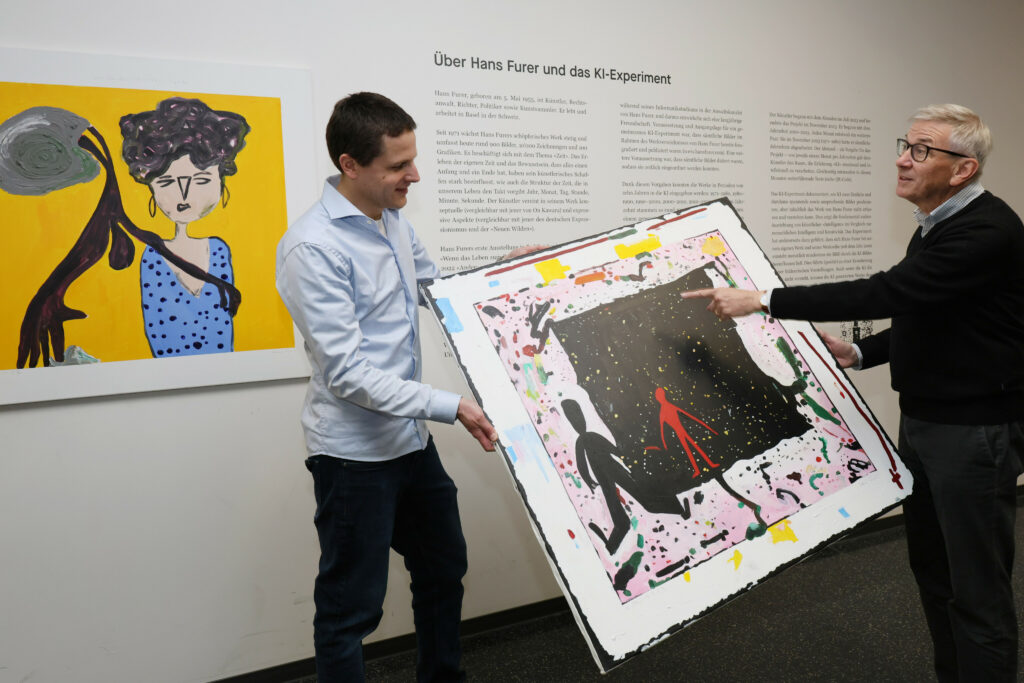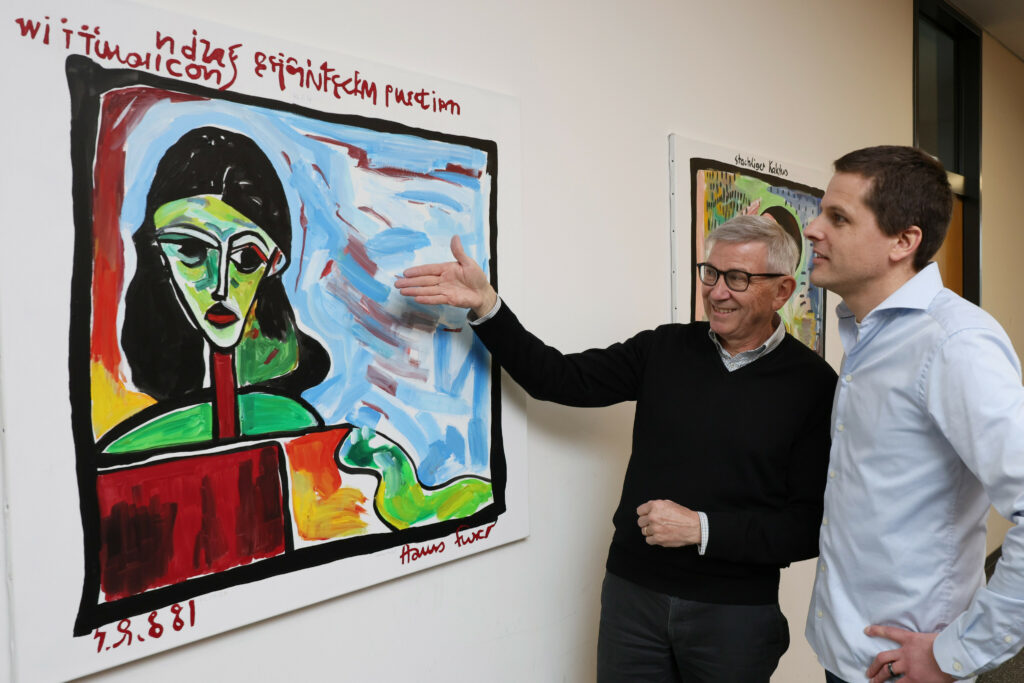About Hans Furer and the AI-Experiment
About Hans Furer and the AI-Experiment

ltr Hans Furer and Prof. Bernhard Egger when installing the pieces on 07.03.2024
Foto: Kurt Fuchs/FAU
Hans Furer, born on 5 May 1955, is an artist, lawyer, judge, politican and art collector. He lives and works in Basel, Switzerland.
Since 1971, Hans Furer has created a constantly growing body of work that today includes around 900 images, 10,000 drawings and 100 graphics. Hans Furer’s work deals with the theme of “time”. The experience of one’s own time and the awareness that everything has a beginning and an end have strongly influenced his artistic work, as has the structure of time, which determines our lives like a beat in year, month, day, hour, minute, Second. The artist sees in his work a conceptual side (most comparable to On Kawara) and expressive (most comparable to German Expressionism and the “Neue Wilden”).
Hans Furer’s first exhibition in Bad Reichenhall in 2020 was called “When life becomes a project”, his second in Basel in 2022 was called “Different and Equal”. He has also published three accompanying books: “Time” (2000), a catalog raisonné of his paintings, which was intended to make the structure of the work better understandable for outsiders (2014), and a catalog raisonné of his linocuts (2022).
The AI experiment is based on a suggestion from Bernhard Egger. He is a junior professor for cognitive computer vision in the Department of Computer Science at the Friedrich-Alexander-Universität Erlangen-Nürnberg. Bernhard Egger worked in Hans Furer’s law firm while studying computer science, and a long-term friendship developed from this. The prerequisite and starting point for a joint AI experiment was that all of the images in Hans Furer’s catalog raisonné had already been photographed and published (www.hansfurer.com). Another requirement was that all pictures were dated so that they could be classified in time.
Thanks to these specifications, the works could be entered into the AI in periods of ten years: 1971-1980, 1980-1990, 1990-2000, 2000-2010, 2010-2023. Around 100 images come from each decade and were fed into a generative image model as training data. The AI generated numerous images as a “mixture” from the images from each period. From these, Bernhard Egger and Hans Furer selected one for each decade for the exhibition.
Hans Furer painted each AI image in its standard format (1 x 1 m, acrylic on canvas) exactly according to the electronic specifications. Hans Furer describes and titles the resulting paintings as “AI paintings”. The artist then selected another picture that he had actually painted in the respective time period and painted that too – the “replica”. The pair (AI image and replica) represent the respective decade. The aim was to show the audience the AI image and replica as something similar but different.

ltr Hans Furer and Prof. Bernhard Egger when installing the pieces on 07.03.2024
Foto: Kurt Fuchs/FAU
The artist began painting in July 2023 and completed the project in November 2023. He began with the decade 2010-2023. Every month another pair was created. By November 2023 (1971–1980) he had completed all decades. The interval – as a requirement for the project – of one month per decade gave the artist the space to process the “AI” experience emotionally and intellectually. At the same time, additional texts were created during these months.
The AI experiment documents how AI can produce similar and certainly exciting and appealing images, but cannot capture and understand the content of Hans Furer’s work. This shows the fundamentally different orientation of artificial “intelligence” compared to human intelligence and creativity. On the other hand, the experiment led to Hans Furer allowing himself to be influenced by the AI images in his own work and his series of works (at least one picture has been created every month since 2000). This led (positively) to an expansion of his artistic ideas. Even if the AI does not understand the images, the AI-generated works can still influence future creations as a source of inspiration.
Hans Furer and Bernhard Egger, March 2024